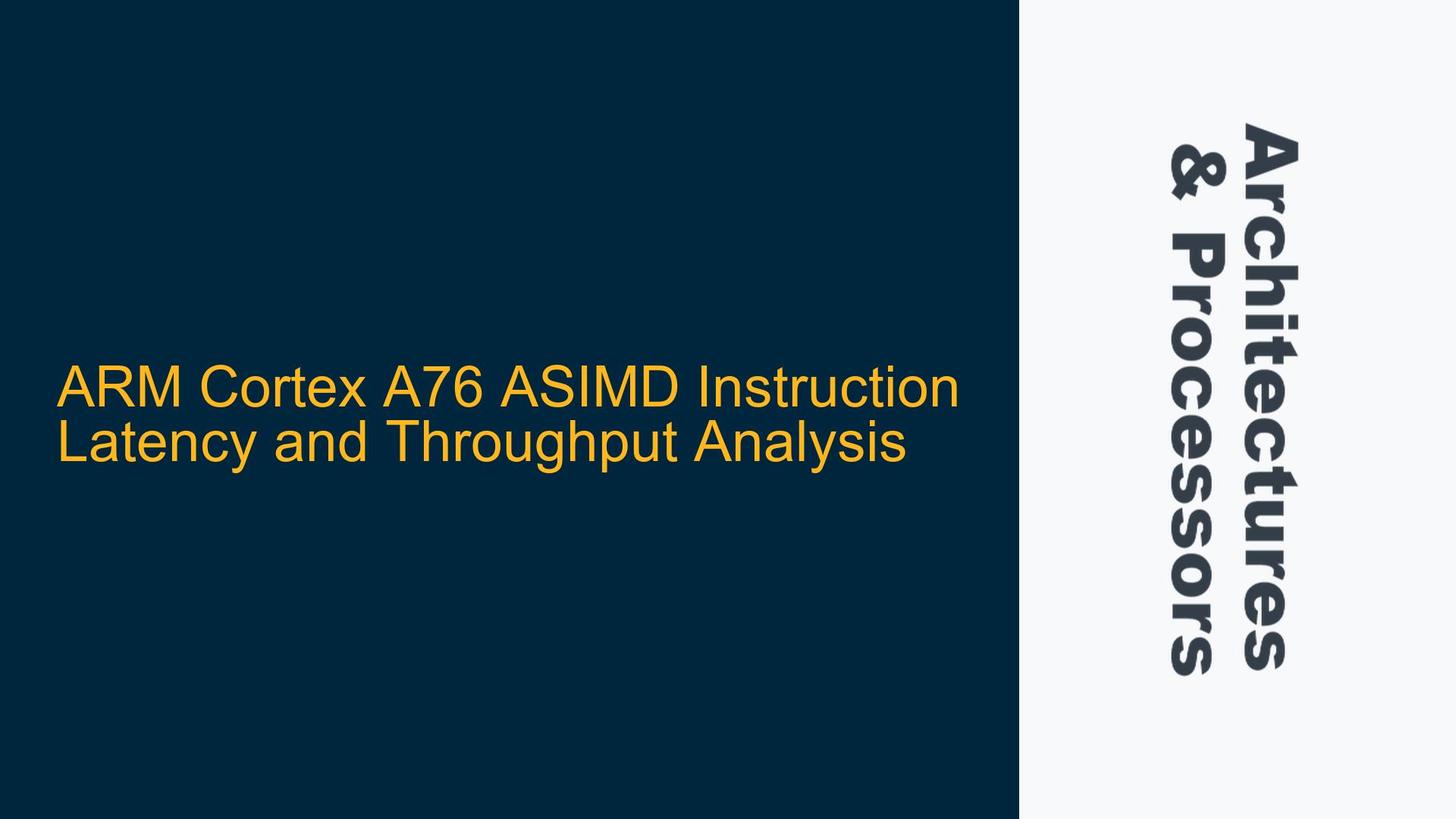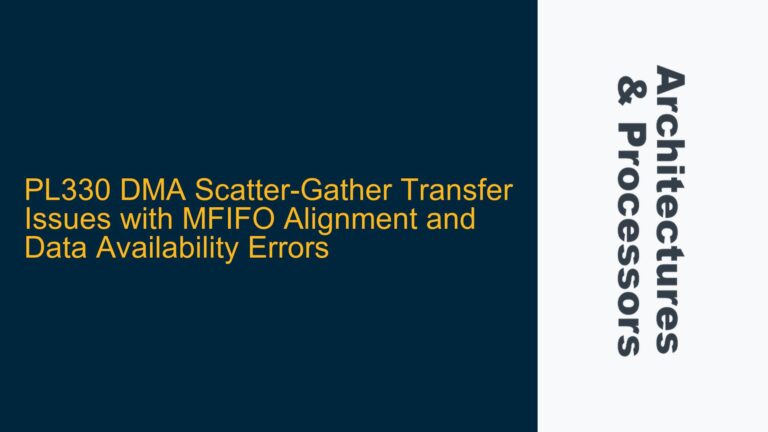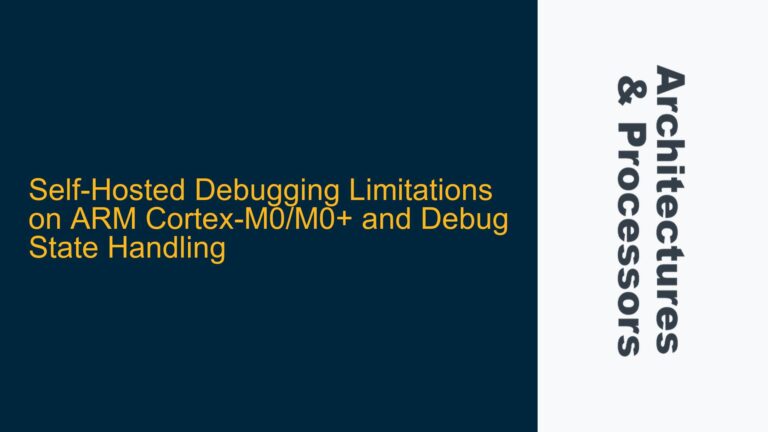ARM Cortex A76 ASIMD Instruction Latency and Pipeline Utilization
The ARM Cortex A76 is a high-performance processor core designed for mobile and embedded applications, featuring Advanced SIMD (ASIMD) instructions that accelerate data-parallel operations. A critical aspect of optimizing code for the Cortex A76 is understanding the latency and throughput of ASIMD instructions, particularly those utilizing the V pipelines (V0 and V1). Latency refers to the number of clock cycles required for an instruction to produce a result, while throughput indicates how many instructions can be executed per cycle. For ASIMD instructions, even simple operations like AND, NOT, NEG, and SHL exhibit a minimum latency of 2 cycles, which is higher than comparable x86 SSE/AVX instructions that often achieve 1-cycle latency. This behavior raises questions about the underlying architecture and implementation of the ASIMD instruction set on the Cortex A76.
The Cortex A76’s ASIMD execution units are designed to handle 128-bit wide vector operations, but the internal implementation may involve splitting these operations into smaller chunks, such as 64-bit halves, to align with the FPU’s capabilities. This design choice could explain the 2-cycle latency for simple instructions, as the processor might process the upper and lower halves of the 128-bit registers sequentially. Additionally, the Cortex A76’s pipeline structure and resource allocation for ASIMD instructions play a significant role in determining latency and throughput. The V pipelines are shared among multiple ASIMD operations, and the processor must manage dependencies and resource contention, which can further impact performance.
Understanding these architectural details is crucial for developers aiming to optimize code for the Cortex A76. By analyzing the latency and throughput of ASIMD instructions, developers can identify critical paths, minimize dependencies, and maximize parallelism to achieve optimal performance. The following sections delve into the possible causes of the observed latency and provide detailed troubleshooting steps and solutions to address these issues.
Memory Access Patterns and FPU Implementation Constraints
One of the primary factors contributing to the 2-cycle latency of ASIMD instructions on the Cortex A76 is the memory access pattern and the constraints imposed by the FPU implementation. The Cortex A76’s FPU is optimized for 64-bit operations, and when handling 128-bit ASIMD instructions, the processor may split the operation into two 64-bit halves. This splitting introduces additional cycles, as the FPU processes the lower 64 bits first, followed by the upper 64 bits. This sequential processing aligns with the historical design of ARM processors, such as the Cortex A8 and A9, which also employed similar strategies for handling wide vector operations.
Another contributing factor is the memory subsystem’s behavior during ASIMD operations. The Cortex A76 employs a load-store architecture, where data must be loaded into registers before being processed by ASIMD instructions. The memory access latency, combined with the FPU’s sequential processing, can result in the observed 2-cycle latency for simple ASIMD instructions. Additionally, the Cortex A76’s cache hierarchy and memory bandwidth play a role in determining the overall performance of ASIMD operations. If the data required for an ASIMD instruction is not available in the L1 or L2 cache, the processor must wait for the data to be fetched from main memory, further increasing latency.
The Cortex A76’s ASIMD execution units are also subject to resource contention, as multiple instructions may compete for access to the V pipelines. This contention can lead to stalls and increased latency, particularly in highly parallel workloads. To mitigate these issues, developers must carefully manage memory access patterns, ensure data alignment, and minimize dependencies between ASIMD instructions. By understanding the constraints imposed by the FPU and memory subsystem, developers can optimize their code to reduce latency and improve throughput.
Implementing Instruction-Level Parallelism and Cache Optimization Techniques
To address the latency and throughput challenges associated with ASIMD instructions on the Cortex A76, developers can employ several optimization techniques. One effective approach is to maximize instruction-level parallelism (ILP) by reordering instructions to minimize dependencies and maximize the utilization of the V pipelines. By carefully scheduling ASIMD instructions, developers can reduce stalls and ensure that the processor’s execution units are fully utilized. This approach requires a deep understanding of the Cortex A76’s pipeline structure and the dependencies between instructions.
Another critical optimization technique is cache management. Since the Cortex A76’s ASIMD performance is heavily influenced by memory access latency, developers should strive to keep data in the L1 and L2 caches. This can be achieved through techniques such as loop unrolling, data prefetching, and cache blocking. Loop unrolling reduces the overhead of loop control instructions and increases the number of ASIMD instructions that can be executed in parallel. Data prefetching involves loading data into the cache before it is needed, reducing the likelihood of cache misses. Cache blocking divides data into smaller blocks that fit within the cache, minimizing the need to fetch data from main memory.
Additionally, developers can leverage the Cortex A76’s support for data synchronization barriers and cache management instructions to ensure coherency and reduce latency. Data synchronization barriers prevent reordering of memory operations, ensuring that ASIMD instructions operate on the correct data. Cache management instructions, such as cache invalidation and cleaning, can be used to maintain cache coherency and reduce the impact of cache misses on ASIMD performance.
Finally, developers should consider the impact of vector width on ASIMD performance. The Cortex A76’s ASIMD execution units are optimized for 128-bit operations, but wider vectors, such as those used in Scalable Vector Extension (SVE) instructions, may incur higher latency due to the need to split operations into smaller chunks. By understanding the trade-offs between vector width and latency, developers can choose the most appropriate instruction set for their application and optimize their code accordingly.
In conclusion, the 2-cycle latency of ASIMD instructions on the ARM Cortex A76 is influenced by a combination of architectural constraints, memory access patterns, and resource contention. By employing instruction-level parallelism, cache optimization techniques, and careful management of vector width, developers can mitigate these challenges and achieve optimal performance for their applications. Understanding the underlying architecture and implementation of the ASIMD instruction set is key to unlocking the full potential of the Cortex A76 and delivering high-performance embedded solutions.






